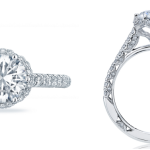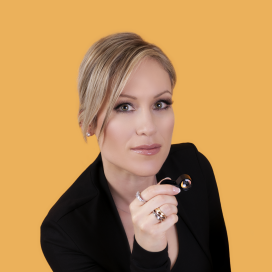Understanding ASET vs Ideal Scope For Light Performance
*Note: ODBA no longer recommends EnchantedDiamonds.com
Q:
Hello Liz,
Thank you for your complimentary advice. I am looking for a round cut diamond that has the following properties:

AGS’s ASET scope on left and Garry Holloway’s Ideal-Scope® on right.
1.2 ct+, I or higher, SI1 or higher with budget of around $8K with ideal light performance. But I also hope it could also be eye-clean. If not then hopefully eye clean enough from 5 inches from viewing the diamond at 5 inches. If you can help me look for more that would be great.
I will be going to the diamond district to take a look at some diamonds this weekend, since I have never seen real diamonds up close before. Are there any tips you might recommend? Do you recommend that I get an ideal-scope or ASET scope to bring with me to look at the diamonds?
Thanks,
Kim
A:
Hi Kim,
I recommend only looking at diamonds that have a GIA or AGS grading report. I would also recommend not purchasing anything without a clearly stated (on paper) refund policy.
If you can purchase an ASET scope, that would be ideal.
Good luck – happy diamond shopping!
Kind Regards,
Liz
Q:
Hi Liz,
I was curious why you would recommend an ASET scope over an ideal scope. Can you explain? Is it better to use the ASET because its easier to use, or its better for the lighting in the stores?
Thanks,
Kim
A:
Hi Kim,
A little background on each…
The ideal-scope was created by Gary Holloway in the early 2000’s and is a very simple tool used to generally determine a diamond’s overall brilliance as well as light leakage. The red/pink areas in this lense gets broken down into finer gradations (bright red, pinks, light pink, etc.).
In 2005, AGSL (American Gem Society Laboratories) created the ASET (Angular Spectrum Evaluation Tool) to assess a diamond’s interaction with light. It was developed to be used with the performance based AGS diamond cut grading system. The ASET tool evaluates light performance and provides a higher level of detail than the ideal-scope by color coding the light that enters a diamond’s crown. Specifically: red represents direct light reflection (to the observer’s eye), green represent reflected light (less intense light reflection), blue represents obscured light (dark contrast) and black/white represents light leakage.
Of course either scope is better than nothing, but I think you’ll find the ASET scope easier to distinguish light performance simply because there are three distinct colors representing different levels of light reflection. I personally glean more information quickly and easily using and interpreting the ASET images for all shaped diamonds.

The same diamond ring as viewed through the ASET scope and the ideal-scope. The ASET image shows clear definitions of light intensity with the clearly visible red, green and blue distinctions. The ideal-scope shows similar information, but is more difficult to interpret for the novice user.
Since you are looking for a 1.20ct+, I or higher, SI1 or higher with budget of around $8K with ideal light performance….
I did happen to find this 1.31ct I VS2 for $8,130.00: https://enchanteddiamonds.com/diamonds/view/Round/GIA-Certified-1,31-Carat-I-Color-VS2-Clarity-Diamond-NL9JKE
This 1.31ct measures 7.02×7.05mm which is the same dimensions as the 1.32ct from Zoara. However this diamond has a smaller table % and a depth of 61.6% with a pavilion angle of 40.6. The overall effect is a more symmetrical diamond that reflects light better.
This diamond also has no blue fluorescence. The grade making inclusion are a few small feathers although this diamond is perfectly eye-clean.
Although there is a $1K difference in price, the reason why the 1.31ct I VS2 costs more is because it doesn’t have blue fluorescence and it has better overall cut proportions.
I wish you all the best!
Take care,
Liz
Hey.You Want Ideal Cut Diamonds?
You've got it.
Join ODBA's Diamond Deal Friday and get handpicked diamonds every week from me to you.
No consultation required. Subscribe now!
ODBA Recommends
You May Also Like






